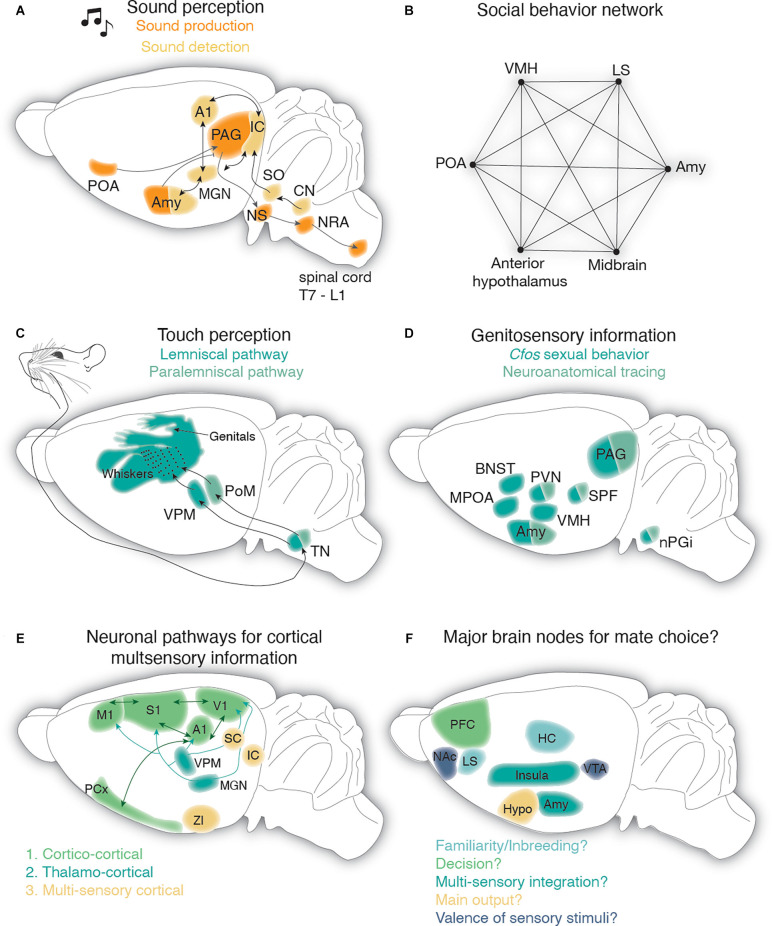Figure 3.
Neural circuits for audition and somatosensation in the context of rodent mate choice. (A) Sound detection pathway is depicted in light yellow: auditory information from the cochlea is transmitted via the cochlear nerve to the cochlear nucleus (CN) which sends information to the superior olive from where it reaches the inferior colliculus. From the inferior colliculus, auditory information reaches the auditory cortex (A1) or amygdala (Amy) via the medial geniculate nucleus in the thalamus (MGN). IC and MGN are reciprocally connected with A1. Reciprocal connection between MGN and Amy has been observed as well. Sound production pathway is highlighted in orange: the periaqueductal gray (PAG) has been involved in mate choice produced USVs and receives auditory related feedback from the preoptic area (POA) and Amy. From the PAG information is sent to vocal pattern generators in the brain stem (nucleus solitarius, NS and nucleus retroambiguus, NRA) and from there is further processed in the spinal cord. (B) The social behavior network as postulated by Newman (1999) consists of reciprocal connections between the ventromedial hypothalamus (VMH), the later septum (LS), the amygdala (Amy), the midbrain, the anterior hypothalamus, and the preoptic area (POA). (C) Touch vibrissae information travels from the periphery through the trigeminal nucleus (TN) in the brainstem to the thalamus. In the thalamus, information is relayed via the ventral posteromedial (VPM) and the medial posterior complex (POm) nuclei to the vibrissae portion of the primary somatosensory cortex (S1): the barrel cortex. (D) Genitosensory information has been shown to activate various subcortical structures, including brain areas of the social behavior network, as revealed by cfos studies in male and female rats. Ascending genitosensory encoding information from the penis and vagina in line with unraveling cfos activitiy during sexual behavior revealed the nucleus paragigantocellularis (nPGi), the subparafascicular nucleus (SPF), PAG, periventricular nucleus of the hypothalamus (PVN), and Amygdala (Amy). BNST, bed nucleus of stria terminals; MPOA, medial preoptic area. (E) Potential pathways leading to multisensory processing in primary cortical areas (M1, primary motor cortex; S1, primary somatosensory cortex; A1, primary auditory cortex; V1, primary visual cortex; PCx, piriform cortex): cortico-cortical connections are depicted in dark green. Thalamocortical connections carrying multimodal information are drawn in turquoise (VPM, ventral posteromedial thalamus; MGN, medial geniculate nucleus) and connections from multisensory integration centers are shown in light yellow (ZI, zona incerta; IC, inferior colliculus; SC, superior colliculus). (F) Postulated major brain nodes implicated during mate choice. Prefrontal cortex (PFC) may account for the active decision to mate. The lateral septum (LS) and hippocampus (HC) might be responsible for individual and (non)familiar recognition of potential mates. The Insula and amygdala (Amy) are proposed to be the main integrators for multimodal information. The hypothalamus (Hypo) is most likely an active output player during mate choice as it has been described during other socio-sexual behaviors. The reward pathway of the ventral tegmental area (VTA) and nucleus accumbens (NAc) encodes the valence of sensory stimuli during mate choice.

